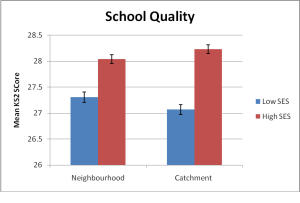Rebecca Allen and Simon Burgess
This week the House of Commons Education Select Committee published its report on the teaching profession. This post gives the main points of our evidence to the Committee.
We think of Initial Teaching Training (ITT) as encompassing both the initial training and the probationary year. How should this be set up to produce the most effective teachers who will have the greatest impact on pupil progress? ITT plays two roles for the profession – training and selection with the emphasis typically placed on the former. Both are important and neither should be neglected, but we argue that the evidence suggests that if anything, selection is the more important, and this is our focus here. An important role for selection is completely standard for any professional accreditation system in either public or private sectors.
The key argument is this: the sharpest selection should be made at the point when the evidence on ability is strongest. The final decision on who can become a teacher should be made when we have accumulated enough evidence on the candidate’s teaching effectiveness. Where is this point in teaching? The two central relevant facts are that variations in teacher effects on pupil progress are very substantial, and that the future effectiveness of a potential teacher is hard to judge from their own academic record.
We believe that the current operation of selection in ITT (tight at the beginning, negligible thereafter) is the wrong way round. Instead, we should let a broader group try out to be teachers, but enforce a much stricter probation policy based around measures of teacher effectiveness in facilitating pupil progress. Full certification and an open-ended first job would only be granted once performance data showed a teacher to be effective. The expectation would be that only the most effective teachers would make it through to full certification.
Selection into ITT is about gaining a place on a course. The difficulty faced in identifying people likely to be good teachers is very relevant here. It is very hard to tell who will be a good teacher and therefore a high degree of agnosticism would be appropriate when faced with applicants. This is certainly true for selection based on objective criteria from the applicants’ own academic records. We know that these are unrelated to teaching ability, and so should be irrelevant in selection into ITT. Beyond that, even if selectors are highly skilled at spotting potential, and it is not clear that they are, it is impractical to ask each applicant to teach a practice lesson. Therefore, selection into ITT should be very broad, with a relatively low academic entry requirement. This of course is not the situation now, nor the direction of travel of current policy. The tightening of academic entry requirements into teaching is not helpful: it will restrict the quantity of recruits and have no impact at all on average teaching effectiveness.
Graduation from ITT should also be tough. Given that much of an ITT course is now school-based, time spent in the classroom will form an important part of the assessment. Arguably the classroom experience is the key part of the course. However, in such a short space of time it will not generate sufficient data for a robust and objective view of the trainee’s effectiveness. It will nevertheless allow the trainee to discover whether teaching is for them.
Once in a job in a school, the progression to being a qualified teacher should be very different to the typical experience now. The key decision on final certification should be made after a probation period of say three years and ideally, the probation should involve classes of varying ability and year group. The period probably cannot be less, though the appropriate length of the probation would need to be analysed properly, depending on the statistical reliability of any pre-hire indicators, school-based performance data, and the cost of being wrong. This is the point when enough data is available to make a reliable judgement on the effectiveness of the teacher. There should be an expectation that not all will make it through to final certification, and indeed only the most effective should be retained. The key judgement should be a minimum threshold of progress that the probationer’s pupils make. Obviously, the measurement of that progress and the parameters of the threshold require a great deal of careful work. Like any statistical data, estimates of teacher effectiveness will never be perfect, and a good deal of evidence over a number of years will be necessary to reach a decision, but this is clearly necessary to raise the average effectiveness of the teaching profession in England.
Another innovative route into teaching is through Teach First. In some ways this is a positive development, as it allows a lot of people to try out teaching and also gives the schools which employ them an ‘out’ at the end of the two years. On the other hand, it restricts entrants based on their academic background.
It is important to see the teacher labour market as a whole, and to see how the different stages of a teacher career fit together. It seems to be very hard to fire ineffective teachers. While the regulations on this have recently changed, generating a culture that encourages headteachers to take a more proactive stance seems harder. While this may change, it may be that the best way to reduce the problem of low-performing teachers is to make it very difficult for ineffective teachers to get into the profession in the first place.
These changes would make starting out on a teaching career much more risky financially. In order to maintain the same average lifetime expected income from the profession, the pay rate of those making it through to final full certification will need to be higher. And the lower is the chance of making it through, the higher is the full professional pay.
In summary, we think that the evidence shows that the selection aspect of ITT is completely the wrong way round. Selection is tight to get into ITT in the first place, but once in, progression to full certification is normal and expected. The process needs to be more appropriately agnostic about likely teaching ability in the first place. It should also allow a broader group of people to try out teaching, but have a much tougher probation regime before trainees be given final certification. It makes much more sense to make final decisions later once more evidence on effectiveness has accrued.




